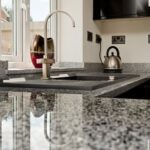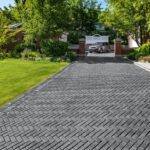Granite has been a popular choice for construction for many years. It’s known for being one of the strongest and most durable materials available. Plus, it adds both beauty and practicality to any space where it’s used.
Thanks to its impressive strength and stylish appearance, granite continues to be a favorite for modern homes and offices around the world. It also comes in various finishes, so you can pick the one that best suits your needs.
One of the most remarkable things about granite is its uniqueness. No two granite slabs will be ever precisely the same, even if extracted from the same quarry. As it is comprised of various types of minerals, the color variation of a granite slab predominantly depends on the presence of minerals in it. General light-hued igneous rocks called granite include granodiorite and syenite. On the other hand, dark-color igneous rocks including black granite are made up of basalt, gabbro diabase, anorthosite, and diorite.
Popular granite surface finishes and their respective applications
Polished Finish
A polished finish is the most popular choice for granite surfaces. The main goal of this finish is to highlight the natural beauty of the stone and bring a touch of elegance to any area. A polished surface shines like a mirror, giving off a radiant glow that catches everyone’s attention. This finish also enhances the granite’s true color and unique charm, making it stand out beautifully.
A polished finish is much like an inherent part of stone processing and is done on almost all countertop surfaces to make it smoother. Similarly, this finish is pretty much common in flooring too.
At stone processing facilities, polish is done through a grinding and buffing process that is meant to give the stone surface a glossy, slippery finish. The stone slab passes through a range of polishing wheels with attached abrasive pads.
Honed Finish Granite
Honed Finish Granite comes with a matte appearance. It is Preferred for flooring because of its non-slippery property. Its non-slippery feature makes it popular among all trending granite finishing types. The honed granite finish has a natural texture and look. This finish is less shiny than a polished finish. In this Dark granites are achieved to result in a light or greyer look. This finish is perfect if you are looking for a more gloomy, natural look for your countertops. However, it is not stain-resistant and easy to clean.
Applications
- It is the best choice for countertops and backsplashes because of its smoothness.
- It is preferred for flooring due to it being less slippery.
Pros and Cons
- This granite finish conceals spots and small imperfections in the stone. It provides a stylish appearance to the stone.
- Honed Finish granite slightly fades the stone’s natural color and texture. It has stains lesser than polished granite.
Leather finish/CARESSED
A very recent finishing technique is the leathered finish, often known as the brushed finish. It is made by applying texture with subtle dimples to a sharpened surface using diamond-tipped brushes. Finishes with leather tend to look more upscale. Unlike countertops with a honed surface, leathered countertops frequently retain the color of the natural stone.
This is relatively new compared to other granite surface finishes and is quickly gaining appeal in the décor sector. It has a rough appearance and a slight shine that is less polished.
Flamed Finish
This finish is characterized by a bit bumpy stone surface. The finishing process also alleviates the stone finish to some shades, leading to a more faded, rustic, and lighter look.
As its name indicates, this finish is achieved by exposing a high-intensity flame to the stone surface, which causes the surface to spurt and become coarse. It is an ideal finish for outdoor applications where a non-slip surface is required.
Bush Hammered Finish
This finish is achieved by hammering the stone with multiple steel brushes that tend to break the surface and cause pits. Alike the flamed finish mentioned above, bush-hammering is a process for preparing extremely slip-resistant surfaces. It can also be utilized to reconstruct the look of a primitive polish when the stone was used to be hand-chiseled. Eventually, gentle brushing using steel brushes is done to give the surface a “time-worn” look.
Brushed Finish
Brushed finish granite is created by brushing its surface gently until it becomes textured. Due to the application of brushing, granite stones with this finish become more porous as compared to polished granite. Similar to a honed finish, a brushed finish attenuates the color of the granite.
A brushed finish granite carries the power to conceal imperfections and scratches, which are quite common during usage.
Lapotra Finish
It is well known that Italy is where the term “Lapotra ” originated. To generate a Lapotra finish, the granite surface is first ground by employing an abrasive to remove the polish. Other stone abrasives are then used to remove scratches from the stone. The leather finish is then applied using various stone brushes with the following numbers: 26, 60, 80, 120, 240, 320, and 500. To achieve a final stone finish that is a combination of muted and gloss, and less shiny, three additional unique stones with the numbers 800, 1500, and 3000 are then used. Granite with a Lapotra finish has a grainy, tarnished appearance that is incredibly fashionable. The surface is non-slippery and quick to clean.
Conclusion
When you’re building or renovating your home, choosing the right materials can make a big difference. Granite is a popular choice, but did you know it comes in different finishes? Knowing about these finishes can help you pick the perfect one for your needs, whether it’s for your kitchen, bathroom, or any other area.
This guide will give you a clear understanding of the types of granite finishes, their uses, and their pros and cons. By learning more, you’ll be able to decide which finish suits your space and budget best.


